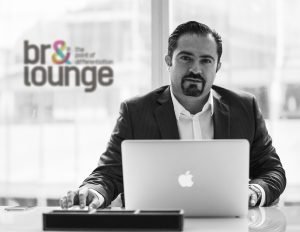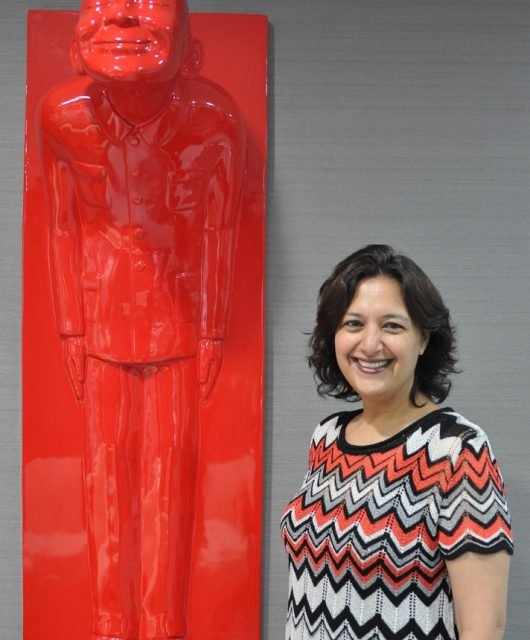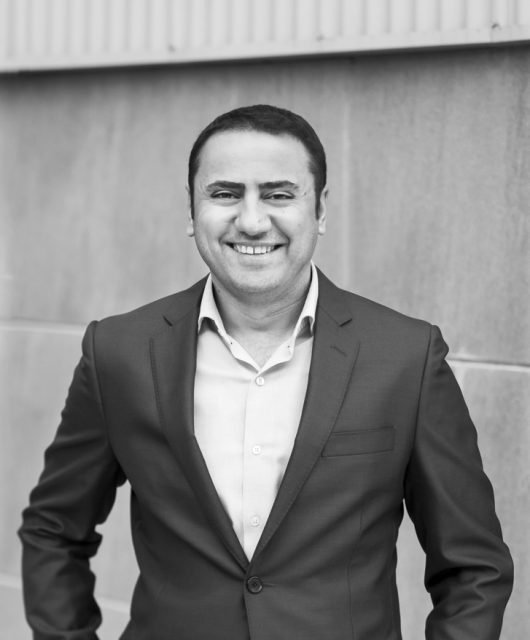The Branders: Q&A With Brand Lounge’s Hasan Fadlallah
With the Middle East market shifting, opportunities rise, environments change and challenges emerge . To sustain and remain ahead of the game, brands in the MENA region need to generate value, capitalize on potential and engage their consumers in experiences that are proactive and purpose-driven. The Berries interviewed Hasan Fadlallah, Founder and CEO of Brand Lounge, to get his take on brand loyalty, brand partnerships, creativity and more.
BB: Brands have different drivers for success, some of them are driven by a unique value proposition and others are driven by a bond that wins over hearts and minds. In your opinion, what should be the ultimate driver for a brand’s success that can create an everlasting impact?
 HF: In the battle for brand loyalty, a brand’s success lies in occupying a unique perception in people’s minds. Truth be told, what’s most important, is the impact that’s inside the mind of the prospect. The key to an everlasting impact is a memorable experience through brands remaining true to their positioning, communication to ensure the delivery of a unique experience to gain constant recognition. There are many factors that could affect the perceived position of a brand in the minds of prospects and lead to failure: technology and digital disruption, change in category and shift in customer usage of a specific product or category, a better experience, and stretching the brand to cover new categories that the brand positioning and hence customer’s perception was not built upon, to list a few.
HF: In the battle for brand loyalty, a brand’s success lies in occupying a unique perception in people’s minds. Truth be told, what’s most important, is the impact that’s inside the mind of the prospect. The key to an everlasting impact is a memorable experience through brands remaining true to their positioning, communication to ensure the delivery of a unique experience to gain constant recognition. There are many factors that could affect the perceived position of a brand in the minds of prospects and lead to failure: technology and digital disruption, change in category and shift in customer usage of a specific product or category, a better experience, and stretching the brand to cover new categories that the brand positioning and hence customer’s perception was not built upon, to list a few.
There are two factors however that are assumed to be key drivers in the success and/ or failure of brands namely brand value and equity , but I would strongly argue that they are not factors. Quality is a given and not a differentiator. Every brand and product should be of excellent quality or they should not exist. The war on quality has been long fought and won. As for price, this is a tricky one but one thing for sure having a low price does not build your brand nor gain you recognition or loyalty, on the other hand high price might. Brands that cannot differentiate themselves nor can they build a positive perception and connection with their prospects have and will continue to resort to low pricing and will remain to be positioned as such.
BB: Several global brand reports have shown that we’ll be seeing more companies working together across different marketplaces in a new reminder that some bridges between brands have to be crossed for mutually-empowered markets. How can brands nurture a culture of brand partnerships and stay competitive to each other at the same time?
HF: The marketplace is over populated with established brands and startups that are fighting their way to gain brand recognition and business from customers, more often than not, it’s the same customer they are after. The concept of co-branding or brand partnership is not new, it is simply not fully endorsed or successfully applied in our region.
We have seen this in the FMCG business with Pepsi and Vodafone in Egypt, Nestle and Tefal in the region, and most recently in the real estate category with Damac properties and Tesla in the UAE. I do agree that this is a trend we expect to see and as branding consultants we would wish to mediate this relation between what we like to call “BLUs” – Brands Like Us; brands/ companies that share similar values and culture and can complement each other by pouring their financial and marketing resources together to create a bigger customer value.
It is very important that this is a strategic initiative based on a proper audit and clear guidelines to insure it is a win-win situation rather than a marketing tactic that could backfire on both brands such as a joint co-branded points scheme that dies within in a year of existence. The wrong reason to enter into such partnerships is to ride on the brand equities of your partner brand and tap into a customer base that is not and cannot be yours simply by tagging along without being true to who you are and what you single handedly stand for and represent. This way you would not only gain the awareness, but also build positive relations and perceptions independently.
BB: The brand scene in the region is very dynamic and full of opportunities and challenges, as well. What is your evaluation of the regional brand scene on both strategic and creative levels?
HF: This is a controversial subject. While we have creative powerhouses in Egypt and Lebanon, and most recently Jordan from a digital creative perspective; the gulf presents tremendous opportunities for enhancement, with outcomes that are on the cliché end of the spectrum or perceived to be more diplomatic.
I would label it as “culturally safe and straightforward” creative output. The biggest worry is not the level of creativity but rather the absence of brands’ sound strategic thinking that has become more than ever a necessity and a need that is yet to be recognized by clients and to be delivered adequately by agencies and consultants.
Brand Lounge was founded in 2006 in partnership with Jack Trout, the foremost marketing guru that has coined the term Brand Positioning which has later on become the number 1 business strategy adopted globally. As such, our belief is that a sound strategy is the backbone for any creative outcome. A brand image communicated through a unique brand identity and visual communication should aim first and foremost to visually translate the brand strategy/ positioning.
From my experience in the branding field, I have come across many cases and projects were the creative routes and designs have been developed simply out of designer’s style and preference or to what is trendy and hip at that time as opposed to the brands’ strategic application. Post creation, the strategy has been articulated as a rationale to what has already been designed and this creates major faults in the brands’ strategic communication. The gulf in this specific instance is more prone to strategic advise as opposed to the creative powerhouses that we mentioned earlier in Egypt and Lebanon. I will remain an advocate of brands’ sound strategic development across the region and hope that a balance is achieved through the MENA region.
BB: Can you mention some tips and tricks to help local brands adapt and survive in 2018?
HF: 2018 is the year of extreme challenges. For those who thought 2017 was difficult and challenging, prepare yourself to fight harder this year. For local brands I tell them watch out for those trends and tips and try to adopt them to be proactive to get ahead of the game, seize the opportunities wisely and continue building your differentiation because people only remember the first man that landed on the moon – here are my tips for 2018:
1) Value Will Become What the Consumer Says It Is
The consumer “voice” will be more important than ever. How consumers define “value” will become more complex, and only the consumer will be able to tell you why they buy the way the do. Any appearance of ambiguity will create troubles for brands seen to have no authentic meaning or emotional resonance to engage consumers. Brands will need to become surrogates for “value” based on what’s wrapped up in the brand promise and what consumers believe the brand means to them. In the consumer-owned, digitally driven marketplace accomplishing this will present a new set of challenges.
2) Consumers Will Only Expect and Talk More
Over the past five years, cross-category consumer expectations have increased 28% while brands generally keep up by only 7%, leaving an unfulfilled gap between what is desired and what is delivered. Expectations will continue to increase. The ability to articulate these expectations will become critical for brand stewards. Minimizing this gap can be achieved by focusing and communicating more within the digital world. Social networking outside of the brand space will continue to increase as consumers become more and more comfortable with their power to get what they see to be credible by relying on reviews of total strangers. Brands will have to drive positive feedbacks in the virtual world like never before, necessitating a deeper understanding of their categories – particularly the emotional aspects.
3) The Funnel Will Continue to Flatten
What marketers call the “purchase funnel” has morphed into a “path-to-purchase,” and will become an extraordinarily category-specific “multi-path-to-purchase.” Content and communication within the right platforms in an effective manner will become the only way to create emotional engagement, which is always positively accompanied with significant brand profits.
4) Real Brand Differentiation Will Become More Emotional
Differentiation will remain a critical aspect to a brands’ success. Every marketer nods at this statement, but it’s becoming more and more difficult to accomplish. While innovation will continue to set ground-breaking records for brands’ expansion, the brand differentiation will only be as successful as it’s ability to emotionally engage with it’s consumers. Marketers will need to continue to use the right platforms, programs, messages, and experiences to connect but brand engagement will be the ultimate objective that will guarantee future growth and customer loyalty.
5) The Ability to Distinguish Between Engagement and Entertainment Will Be Critical
Entertainment is the action of providing amusement. Indeed, it is an effective strategy to gain consumers attention; however, it doesn’t guarantee effective engagement. Valuable engagement is the consequence of any marketing or communication effort that results in an increased level of how well your brand is perceived by consumers to meet their high expectations.
6) You Won’t Be Able to Take Your Eye Off the Brand
Your brand may be popular, but it will need to be recognized for something meaningful and important to consumers. Today, consumers are more visually literate and agile than ever. Hence, videos dominate the social media communities and drive better engagements for brands platforms. Major social networking channels and apps will need to improve feed quality and add interactive features.
BB: With the rise of the millennials as the up and coming purchasing power segment, in your opinion, what makes a brand “millennial-friendly”? What are millennials looking for in a brand?
HF: Many brands on a global and local level have re-visited their brand and business strategies as they become more aware of the millennial’s segment interest. This target audience is now credited with being at least 25% of the consumers buying discretionary products or services. They value product features and design, while also being precautions of pricing. On the other hand, because millennials have been so inundated with advertising all of their lives, they are a market of people who are slightly more difficult to engage. So, rather than selling them something, their utmost attention is captured through information and entertainment,, especially through the use of digital marketing. Millennials also appreciate simplicity, and efficiency; using platforms like social media and mobile friendly sites make it easier to engage with them. Take a look at some brands that were successful in targeting millennials, such as Apple. Although their products are pricier than their competitors, they resemble their value and quality of product. Another example is TOMS, not only do they provide quality products but they also promote the purpose behind their brand, which is giving back to those in need.
BB: Brands always find themselves in a dilemma when picking their partner agencies. In your opinion, should they go to local agencies for their deep understanding of the local context and markets or should they head to the global agencies for their world-class level of creativity? Can you elaborate with some insights on the Emirati market?
HF: The stereotype of “global is gold” has faded away, particularly in the gulf region and in the UAE in specific. With Dubai being the home of all the global agency networks for the MENA region and international branding consultancies; clients and businesses are looking for the “right-fit” wherever it comes from – global or home-grown agencies and consultants. Both have their advantages and limitations but I predict that home-grown/ local agencies and consultants are better poised to manage local businesses in this day and age. Cultural understanding coupled with geographical presence and regional pricing models are the ingredients that will define the “right-fit” model for local and governmental businesses.





